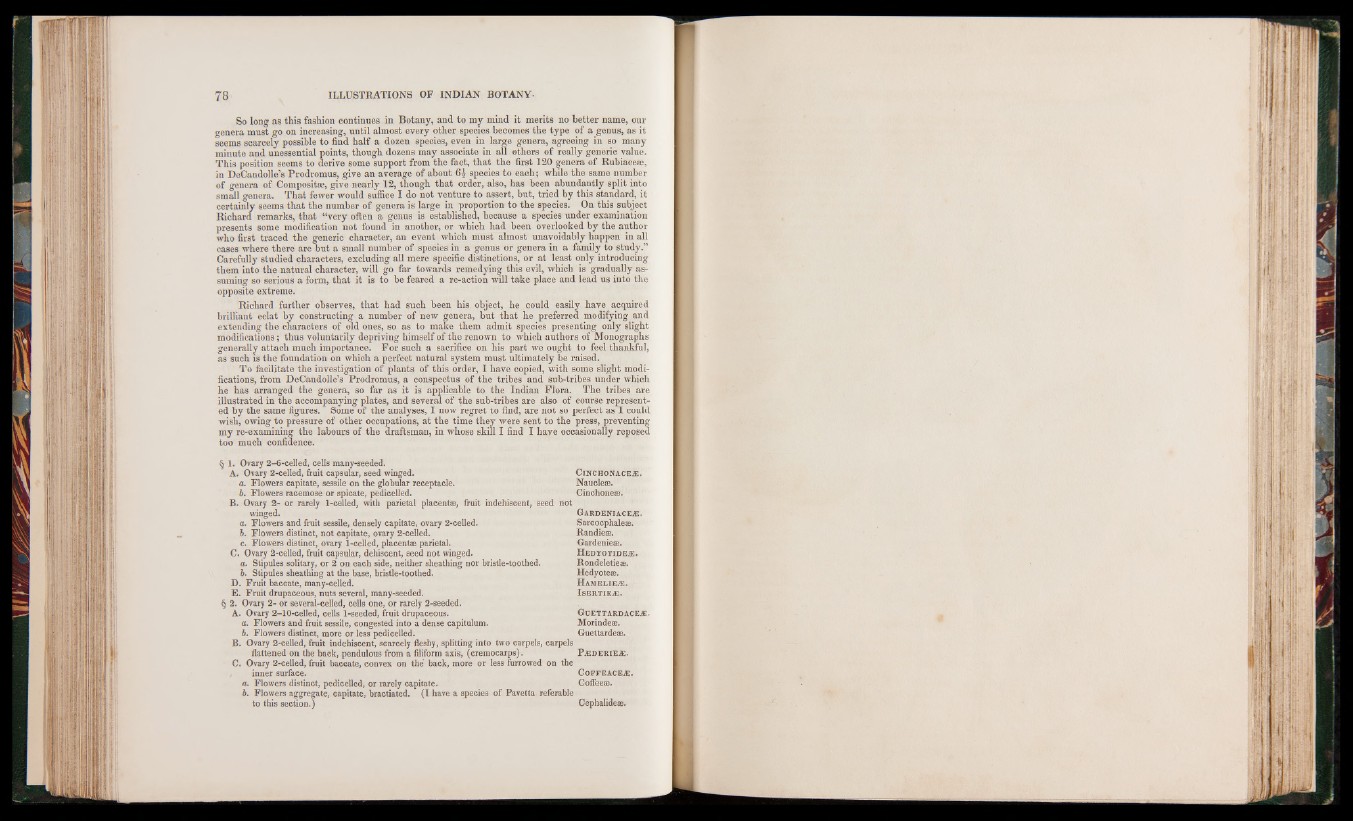
So long as this fashion continues in Botany, and to my mind it merits no better name, our
genera must go on increasing, until almost every other species becomes the type of a genus, as it
seems scarcely possible to find half a dozen species, even in large genera, agreeing in so many
minute and unessential points, though dozens may associate in all ethers of really generic value.
This position seems to derive some support from the fact, that the first 120 genera of Rubiacese,
in DeCandolle’s Prodromus, give an average of about 6£ species to each; while the same number
of genera of Composite, give nearly 12, though that order, also, has been abundantly split into
small genera. That fewer would suffice I do not venture to assert, but, tried by this standard, it
certainly seems that the number of genera is large in proportion to the species. On this subject
Richard remarks, that “very often a genus is established, because a species under examination
presents some modification not found in another, or which had been overlooked by the author
who first traced the generic character, an event which must almost unavoidably happen in all
cases where there are but a small number of species in a genus or genera in a family to study.”
Carefully studied characters, excluding all mere specific distinctions, or at least only introducing
them into the natural character, will go far towards remedying this evil, which is gradually assuming
so serious a form, that it is to be feared a re-action will take place and lead us into the
opposite extreme.
Richard further observes, that had such been his object, he could easily have acquired
brilliant eclat by constructing a number of new genera, but that he preferred modifying and
extending the characters of old ones, so as to make them admit species presenting only slight
modifications; thus voluntarily depriving himself of the renown to which authors of Monographs
generally attach much importance. For such a sacrifice on his part we ought to feel thankful,
as such is the foundation on which a perfect natural system must ultimately be raised.
To facilitate the investigation of plants of this order, I have copied, with some slight modifications,
from DeCandolle’s Prodromus, a conspectus of the tribes and sub-tribes under which
he has arranged the genera, so far as it is applicable to the Indian Flora. The tribes are
illustrated in the accompanying plates, and several of the sub-tribes are also of course represented
by the same figures. Some of the analyses, I now regret to find, are not so perfect as I could
wish, owing to pressure of other occupations, at the time they were sent to the press, preventing
my re-examining the labours of the draftsman, in whose skill I find I have occasionally reposed
too much confidence.
§ 1. Ovary 2-6-celled, cells many-seeded.
A. Ovary 2-celled, fruit capsular, seed winged.
a. Flowers capitate, sessile on the globular receptacle.
b . Flowers racemose or spicate, pedicelled.
B. Ovary 2- or rarely 1-celled, with parietal placentae, fruit indehiscent, seed not
winged.
a. Flowers and fruit sessile, densely capitate, ovary 2-celled.
b . Flowers distinct, not capitate, ovary 2-celled.
c. Flowers distinct, ovary 1-celled, placentae parietal.
C. Ovary 2-celled, fruit capsular, dehiscent, seed not winged.
a. Stipules solitary, or 2 on each side, neither sheathing nor bristle-toothed.
b. Stipules sheathing at the base, bristle-toothed.
D. Fruit baccate, many-celled.
E. Fruit drupaceous, nuts several, many-seeded.
§ 2. Ovary 2- or several-celled, cells one, or rarely 2-seeded.
A. Ovary 2-10-celled, cells 1-seeded, fruit drupaceous.
a. Flowers and fruit sessile, congested into a dense capitulum.
b . Flowers distinct, more or less pedicelled.
B. Ovary 2-celled, fruit indehiscent, scarcely fleshy, splitting into two carpels, carpels
flattened on the back, pendulous from a filiform axis, (cremocarps).
C. Ovary 2-celled, fruit baccate, convex on the back, more or less furrowed on the
ClNCHONACEÆ.
Naucleæ.
Cinchoneæ.
Gardeniaceæ.
Sarcocphaleæ.
Randieæ.
Gardenieæ.
H edyotideæ.
Rondeletieæ.
Hedyoteæ.
I I a m e l i e æ .
ÏSERTIEÆ.
Guettardaceæ.
Morindeæ.
Guettardeæ.
P æ d e r ieæ .
inner surface.
a. Flowers distinct, pedicelled, or rarely capitate.
b. Flowers aggregate, capitate, bractiated. (I have a species of Pavetta referable
to this section.)
CoFFEACEÆ.
Coffeeæ.
Cephalideæ.